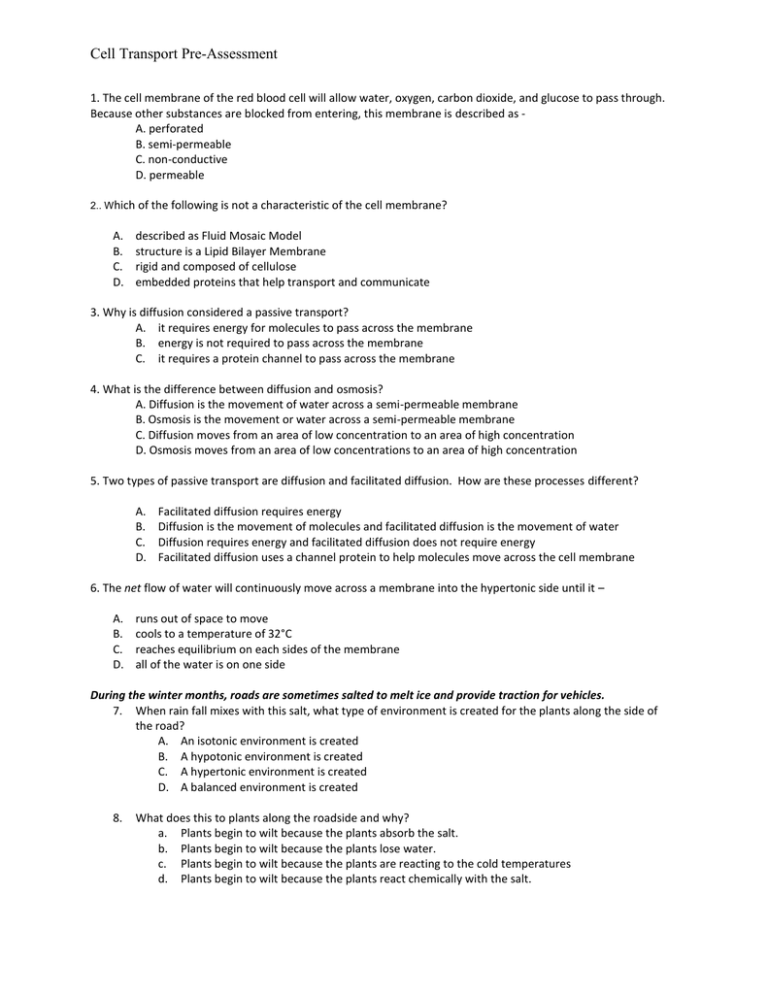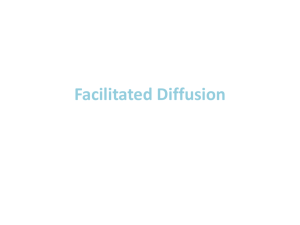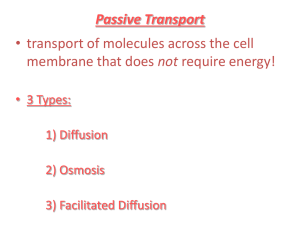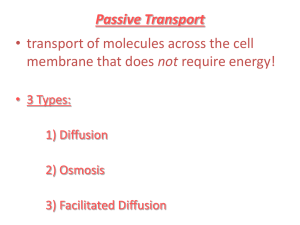Cell Transport Preassessment
advertisement

Cell Transport Pre-Assessment 1. The cell membrane of the red blood cell will allow water, oxygen, carbon dioxide, and glucose to pass through. Because other substances are blocked from entering, this membrane is described as A. perforated B. semi-permeable C. non-conductive D. permeable 2.. Which of the following is not a characteristic of the cell membrane? A. B. C. D. described as Fluid Mosaic Model structure is a Lipid Bilayer Membrane rigid and composed of cellulose embedded proteins that help transport and communicate 3. Why is diffusion considered a passive transport? A. it requires energy for molecules to pass across the membrane B. energy is not required to pass across the membrane C. it requires a protein channel to pass across the membrane 4. What is the difference between diffusion and osmosis? A. Diffusion is the movement of water across a semi-permeable membrane B. Osmosis is the movement or water across a semi-permeable membrane C. Diffusion moves from an area of low concentration to an area of high concentration D. Osmosis moves from an area of low concentrations to an area of high concentration 5. Two types of passive transport are diffusion and facilitated diffusion. How are these processes different? A. B. C. D. Facilitated diffusion requires energy Diffusion is the movement of molecules and facilitated diffusion is the movement of water Diffusion requires energy and facilitated diffusion does not require energy Facilitated diffusion uses a channel protein to help molecules move across the cell membrane 6. The net flow of water will continuously move across a membrane into the hypertonic side until it – A. B. C. D. runs out of space to move cools to a temperature of 32°C reaches equilibrium on each sides of the membrane all of the water is on one side During the winter months, roads are sometimes salted to melt ice and provide traction for vehicles. 7. When rain fall mixes with this salt, what type of environment is created for the plants along the side of the road? A. An isotonic environment is created B. A hypotonic environment is created C. A hypertonic environment is created D. A balanced environment is created 8. What does this to plants along the roadside and why? a. Plants begin to wilt because the plants absorb the salt. b. Plants begin to wilt because the plants lose water. c. Plants begin to wilt because the plants are reacting to the cold temperatures d. Plants begin to wilt because the plants react chemically with the salt. Cell Transport Pre-Assessment 9. A student wants to model the net movement of water into a cell using a semi-permeable bag, water, a large beaker and salt. a. Place a bag containing a 20% salt solution into a beaker containing 40% salt solution b. Place a bag containing a 30% salt solution into a beaker containing a 10% salt solution c. Place a bag containing a 30% salt solution into a beaker containing a 40% salt solution d. Place a bag containing a 10% salt solution into a beaker containing a 10% salt solution






